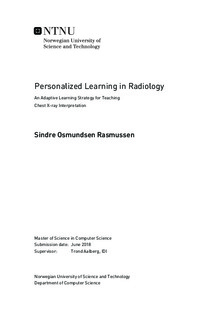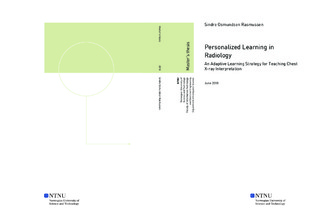| dc.description.abstract | An adaptive learning system is a software system used in education that analyzes a student s
interactions in the system and adapts and presents learning material based on this
analysis. The student gets a personalized learning experience that is tailored to focus on
knowledge the student is lacking, and the knowledge is presented in a way that the specific
student best understands. There are many commercial adaptive learning systems available,
but most of them focus on the most common areas in education. These are areas like
mathematics, language, physics, chemistry, biology or history. There are still some more
specialized areas where there are little or no available adaptive learning systems.
This master's thesis is investigating how adaptive learning can be used to create a learning
system in radiology. More specifically a learning system that teaches students how
to interpret chest X-ray images, so that students learn how to detect serious and possibly
life threatening conditions. There are many different adaptive learning techniques, and a
key question for this thesis is to identify which of these techniques that are applicable in
the teaching of chest X-ray interpretation. Chest X-ray interpretation can in general be
classified as a form of image analysis. Techniques that work here might therefore also be
applicable in teaching other forms of image analysis.
In order to identify the appropriate adaptive learning techniques for chest X-ray interpretation, a prototype system was developed. The development was done in cooperation
with experts in radiology, who gave feedback during the development, and contributed
by creating the learning material the system used as base material when it adapted to students. Three different adaptive methods were developed and implemented in the prototype
system: adaptive case selection, adaptive follow-ups and adaptive task type. After the development the methods had to be tested to see if they managed to adapt to the students.
The testing was done on students of medicine through two user testing sessions, where
the students were observed as they tested the system. The students were also asked to
answer a series of questions in a survey, and the system automatically collected user data
while the students tested the system. Analysis of these data showed that adaptive content
techniques seem to be the preferred category of adaptive learning techniques when developing
an adaptive learning system for chest X-ray interpretation. Also task design should
have a problem-solving focus, where educational instructions are presented, followed by
a problem where the teaching from the instructions can be applied. | |

